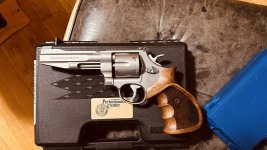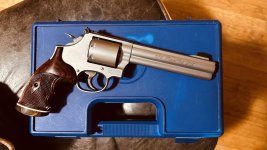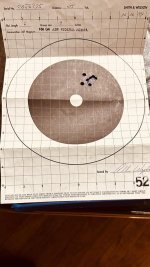This was all fantastic information and I have a series of questions based on your pictures and response.
Firstly I have not been able to locate any super detailed year by year / dash to dash breakdown of the 627. Normally with a smith I first try to understand the iterations of every variation then decide based on my needs.
Dash numbers are not models, nor are they configurations. They are an indication that parts needed to assemble or repair this firearm are different from the next or previous engineering revision
The engineering revisions of Performance Center firearms do not always coincide with production guns of the same model
I never pay attention to engineering revisions. I base my purchases on the revolvers configuration. So I do not know if there is a good resource for that info beyond what is in the SCSW 4th edition
From what I understand aside from the personal preference aesthetically the purpose of a full lug as opposed to a half lug or angled/tapered is to provide additional weight for the shooter. Given that the N frame 627 is larger despite the (5 inch) barrel as opposed to the standard (6 inch) of the 686 variations I have been eyeing (686-3 or 686-2) I believe the weight of the 627 is slightly more. When comparing the modern 686-6 Plus 5 Inch against the 627 5 inch it says that the 627 is slightly heavier. Google tells me that the 686-3 is about 40.5 ounces making the 627 heavier. Whether or not the weight is where it needs to be for reduced recoil for hotter loads is another discussion I don't have the answer to. Also factor in the weight of 2 extra rounds and you have more weight to include when loaded.
When we are only speaking of ounces, it does not make an overly impressive difference. If you wanted to maximize the reduction of muzzle rise, the 6 1/2" 627 Heavy Hunter is the ticket
There were even two made with a 8" barrel.
Would be curious to hear your thoughts on the benefit of the N frame of the 627 and the weight difference and angled/tapered lug versus the full lug of the 686. Additionally although I love the tapered/angled lug (please let me know the correct term for the lug) I am also a fan of the earlier variation 627's with the full lug. If the N frame is in fact more beneficial for weight and stature to handle heavier rounds and the 627 is heavier even as an angled lug would the full lug 627 variation be even more of a shooter since it would be even more heavy?
I have never bothered shooting the longer 686s. I own one of the original 2 1/2" 686s that Lew Horton convinced the Factory to produce, though mine has been scratched up a bit
Prior to Lew Horton insisting on these 2 1/2" revolvers bieng produced, the shortest 586/686 was 4"
I also have a 3" CS-1 and a one of the 4" 686 US Treasury revolvers.
When the 586/686 released I already owned several Model 27s and Pythons, I just never saw the need for adding the 686 into that world.
BTW, angled lug, tapered lug both work fine. For some strange reason the early Factory paperwork called it a profile lug or a contoured barrel. Don't sweat it, we all know what you mean

Next question: As I am currently comparing the modern 627 PC version to the 686-3.. Is there a big difference in the performance between the 627 PC and earlier variations both full lug and angled? Would the differences be worth exploring a different older variation of the 627?
The original Model 627 of 1989 (SKU 101024) is not a Performance Center offering. 5,276 of these were manufactured across four engineering revisions 627, -0, -1 & -2. When the last one was assembled is unknown but the bulk pf the more than 5,000 revolvers were completed in 1989
Most all reaming 627s except the production 4" 8 shot heavy barrel and the 4' 627 pro were Performance Center offerings. The initial 8 shot, 627 introduced at the 1997 SHOT show had an engineering revision of PC (627-PC). The development began in 1996
It was Lew Horton Distributors that convinced S&W to do an 8 shot 357 Magnum revolver. When I got wind of this I called LH and asked to be sent number 357, I like serial numbers. I was told that this was a one time run of 300 firearms. In the upper left corner of this old group photo is the 27th production revolver. It was delivered to me in June of 1997.
The concept was so successful that the entire run was sold out in just several weeks. Usually these runs take at least a year or more to sell out. So Lew decided to do a second run. I received a call frm LH asking if I still wanted number 357. It is the revolver that you see in the upper right of the group photo and was delivered in September of 1997. This run also sold out in record time.
More were produced and eventually the firearm became a cataloged item that is still available more than 25 years later.
Over the years many other configurations were offered.
I have only been able to identify basic aspects of the differences between variations of the 627 such as the following:
-Full lug versions were from 1989-1997, included 6 round capability and hammer mounted firing pin
-627-2 tapered under-lug, floating firing pin, chamfered charge holes, 8 round capability 1997-1998
I am interested in the ability to use moon clips and 8 rounds.
What variations have both those features as well as the tapered under-lug? Is there a non internal locking hole version that includes those features?
Any advice on variations and potential pros and cons of different dash models would be super helpful!
I really appreciate any additional input I've already learned so much from your first response.
Best-
As I have already mentioned, engineering revisions on production and PC guns do not always indicate the same change to the design. The Performance Center manufactures their own frames on their own CNC mills with their own tweaked CNC code.
With the exception of the production 4" model 627 heavy barrel and 2 1/2" Model 327 Night Guard, all of the Factory's 8 shot, 357 Magnum Model 27/327/627 revolvers are cut for moon clips.
The lock was slowly phased into models after lock company Saf-T-Hammer purchased Smith & Wesson in 2001. So all 8 shot 27/327/627s manufactured from 1997 through some time in 2002 do not have the internal lock.
Limiting yourself to non-lock Smith & Wesson prevents you from experiencing more then two decades of revolver development.
Again, I do not pay attention to engineering revisions. It does not matter to me of something is LH or RH threaded or of the Frame Lug is pressed in are milled in. The revolvers all shoot the same.
















